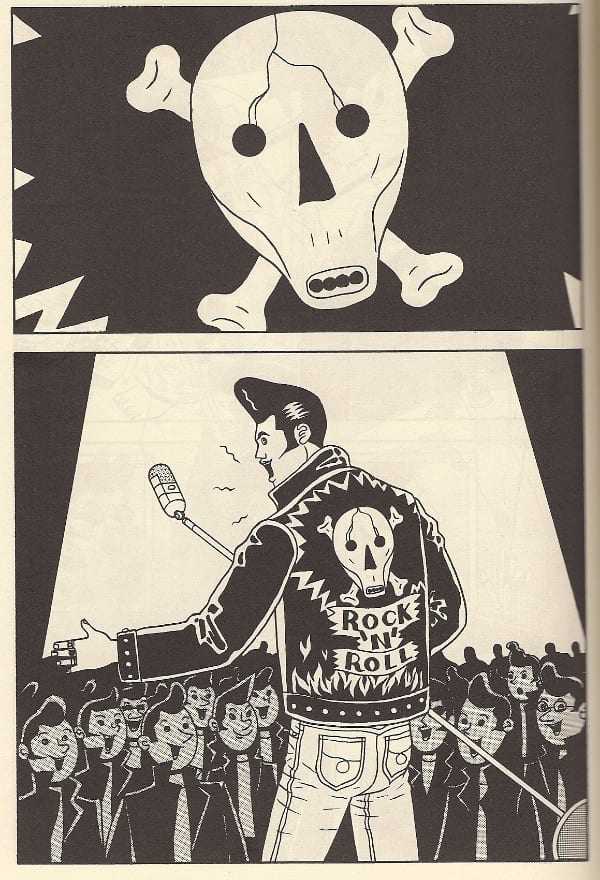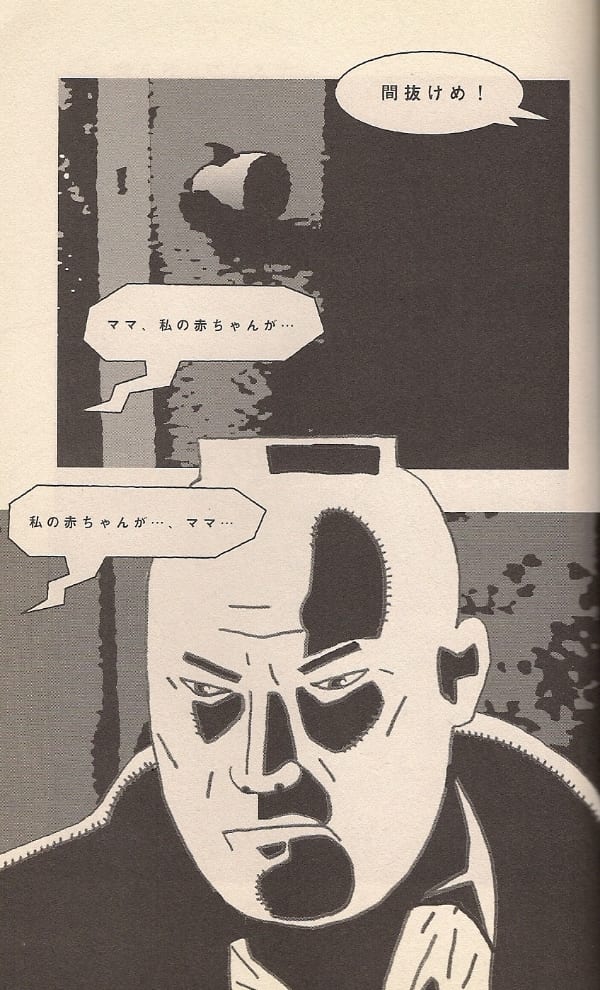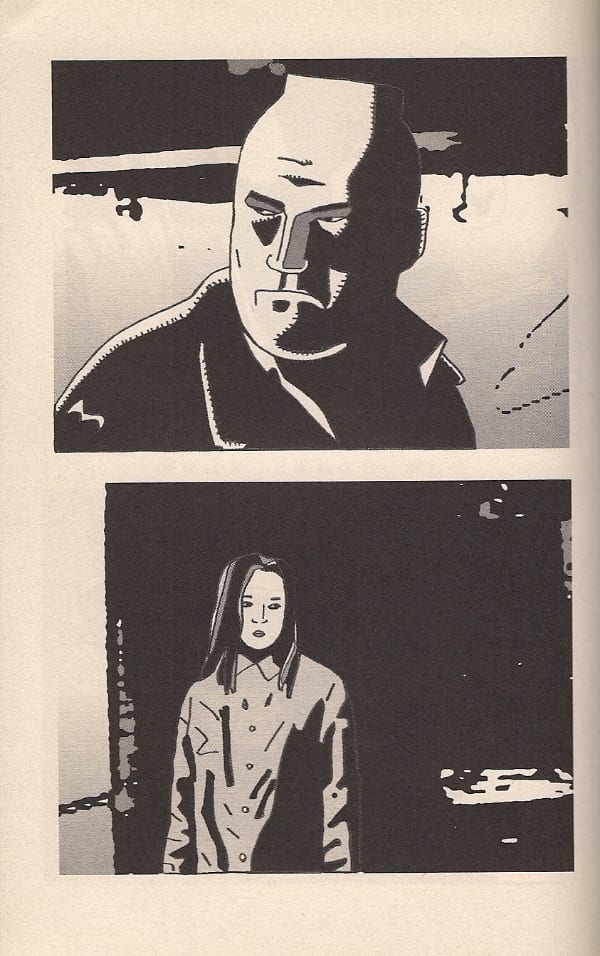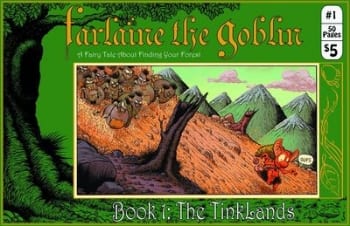"This book, being both partial and subjective, is neither dictionary, nor encyclopaedia. Numerous friends, authors we'd invited to participate and Big Names aren't included; numerous 'unknowns' are, sometimes even for the first time in print. COMIX 2000 is only a reflection of itself. Which, looking at the beast, is the least it could be."
So concludes the introduction to Comix 2000, one of the truly notorious anthologies of the past 15 years of comics, and -- in its defiant heft, dropped like a cinder block onto the market in late 1999, a 2,000+ page hardcover doorstop of wordless comics hailing from dozens of nations -- something of a precursor to the Kramers Ergot era to be introduced by NON No. 5 the following year. It was the capstone to a mighty decade of experimentation by L'Association, perhaps the most important world comics publisher of the '90s, a grand folly "not so much to be read as to be toured," as critic Bart Beaty later remarked.
Indeed, to flip through a copy of Comix 2000 is to become lost in a maze of obscure offerings by unfamiliar names. It is a book of mysteries, centered around a theme of cryptic relevance: the 20th Century.
Above, we see the transformation of life into legacy, the tipping of media toward both nostalgia and recontextualization, and -- perhaps -- a paradigm shift in the appeal of the American global export. It is the work of one "Robot" Okuda: a manga artist born in 1963, per the minimal biographical information provided, and author of such tantalizingly-named works as Tokyo Pistol Boy (1997). Of course, nothing of the sort is available in English, as is the case with so many of the beast's feeders.
 But this didn't stop me, patient reader! I am a shaman of happenstance, and having recently come into contact with certain upstanding citizens of the world at Cugnaux's Timeless -- publishers of small-run art books and international curiosities, with a special focus on weird and grotesque Japanese items ranging from untranslated manga to utterly creepy toys -- I found myself in possession of what might have been Okuda's very next work, from the year 2000, a true curiosity of international exchange: the *official manga adaptation* of French filmmaker's Gaspar Noé's 1998 feature debut, Seul contre tous, released in North America as I Stand Alone.
But this didn't stop me, patient reader! I am a shaman of happenstance, and having recently come into contact with certain upstanding citizens of the world at Cugnaux's Timeless -- publishers of small-run art books and international curiosities, with a special focus on weird and grotesque Japanese items ranging from untranslated manga to utterly creepy toys -- I found myself in possession of what might have been Okuda's very next work, from the year 2000, a true curiosity of international exchange: the *official manga adaptation* of French filmmaker's Gaspar Noé's 1998 feature debut, Seul contre tous, released in North America as I Stand Alone.
I am not privy to the details behind the origins of this project, although it makes a certain amount of sense even from what's available for English perusal; Noé, after all, is by his own admission a longtime comics reader, who had thanked Japanese filmmaker Shinya Tsukamoto in the credits to his original film, and would eventually shoot much of his 2009 feature Enter the Void in Tokyo with a sizable Japanese crew. Speculation might even reveal that he and Okuda perhaps share a fondness for certain aspects of American culture: Martin Scorsese's Taxi Driver, a Noé favorite, looms large over the plot of I Stand Alone, with its broiling working slob protagonist dragged inexorably toward violence in the name of connecting with a helpless young girl.
Okuda takes this interest even further, so that this:
becomes this:
Not quite De Niro, but the haircut inevitably recalls the climax to that 1976 favorite; in this way, Okuda decouples Noé's film from its visual certitude, presenting allusion as sheer demonstration. It's a funny move, insofar as the manga otherwise follows the movie's action very closely, even mimicking Noé's enthusiasm for booming intertitles -- yes, the infamous 30-second warning is duly preserved -- giving the "reader" (from what they can discern from French adapted to Japanese) the vague sense of a record being kept of some earlier performance.
Or maybe something more domestic is happening.
In preserving the virtually non-stop nature of the protagonist's inner monologue, this manga rendition often resembles more of a heavily illustrated novel given over to frequent pages of sequential art. This could well be deliberate: the publisher is Kadokawa Shoten, which in the ensuing decade ramped up production of otaku-friendly, anime-like 'light novels' which this project superficially resembles, though Okuda is unlikely to be found as an inspiration for moe shows anytime soon. Often, his panels seem like digitally altered film stills, and when he's cartooning there's noirish shadows over everything, as if to suggest another doomed mug will inevitably fall prey to his own worst instincts.
But then, there is also the literary genre of the "I-Novel," by which authors such as Osamu Dazai would confess, in lightly fictional terms, their intense passions and (sometimes) social disenchantment through first-person writing. This too, structurally, is the basic the approach of I Stand Alone, and while Noé is not revealing his own personal situation through the work, I suspect the commonalities between his script and this particularly Japanese style were not lost on Okuda, though I cannot read his text, and am left only to study and speculate.
In a way, this all speaks to the mission of Comix 2000. Elsewhere in that introduction, the editors note that "if some of the national mainstream styles may export poorly to other countries (the French-Belgian school, American super-heroes, commercial mangas), their alternatives stem from a truly international culture." Of course, this statement seems misplaced today - in the following decade, France and the U.S. would witness brief explosions of popularity for translation commercial manga, and American superheroes would at least become a major force in global cinema entertainment, albeit of little use to working superhero artists.
Yet still, these works seem nationally cemented, while experiments like Okuda's, and L'Association's, seem theoretically freed to mingle and cohabitate, revealing a little about each end of the cultural influence. It could just be a trick of some lacking translation, though. Sheer speculation. Maybe it's better to leave it all wordless.

***
PLEASE NOTE: What follows is not a series of capsule reviews but an annotated selection of items listed by Diamond Comic Distributors for release to comic book retailers in North America on the particular Wednesday, or, in the event of a holiday or occurrence necessitating the close of UPS in a manner that would impact deliveries, Thursday, identified in the column title above. Not every listed item will necessarily arrive at every comic book retailer, in that some items may be delayed and ordered quantities will vary. I have in all likelihood not read any of the comics listed below, in that they are not yet released as of the writing of this column, nor will I necessarily read or purchase every item identified; THIS WEEK IN COMICS! reflects only what I find to be potentially interesting.
***
SPOTLIGHT PICKS!
Beirut 1990: Snapshots of a Civil War: Being the latest among Humanoids' attempts to localize more traditionally 'bookstore mainstream' fare from Les Humanoïdes Associés, specifically its "Tohu Bohu" collection of works commissioned in response to the great success of L'Association in the '90s. This time it's a 2004 album from artist Christophe Gaultier, drawing upon the narrative of Bruno & Sylvain Ricard, callow visitors to the city in the year of the title, who observe and record several things. It's 160 pages in a 7.7" x 10.5" hardcover. Note that Humanoids also has a new printing of its Alejandro Jodorowsky short-stories-of-the-'00s compilation Screaming Planet due this week. Preview; $29.95.
Farlaine the Goblin Book 1 (of 7): The Tinklands: Here's a refreshing twist on this column's formula - I might be absolutely ignorant of anything relating to this new all-ages b&w fantasy miniseries from "Studio Farlaine," but this time I'm supposed to be, as the creator (a seemingly untested talent to comics) has elected to remain entirely anonymous. Something about that just delights me, as does the unique 11" x 7" landscape format for each issue, with page counts to vary, though the first one's a big 50. From the looks of the homepage it's a pretty slick bit of fantasy, concerning a goblin shaman's search for "a forest to call his own"; $5.00.
--
PLUS!
The Cartoon Introduction to Statistics: Just yesterday I was wondering what Grady Klein was doing - he was the author of a very curious trilogy of historical adventure comics in the early years of First Second (The Lost Colony), and I like to keep tabs on artists I only associate with this very '00s mainstream. As it turns out, he's worked on a number of educational Cartoon Introduction books for Hill and Wang, and this is the 240-page latest, produced in collaboration with Alan Dabney, Ph.D., whom I believe was a colorist for Valiant in the '90s. Okay, no, that's a lie; $17.95 ($30.00 in hardcover).
The Killer Omnibus (&) The Killer Vol. 4: Unfair Competition: It's been a little while since we've seen anything from Archaia's 7" x 10" English editions of this still-going crime series (Le Tueur) from Alexis "Matz" Nolent & Luc Jacamon, so here's a double-hit of stuff, presenting both 128 new pages in hardcover and a 312-page paperback brick of the preceding volumes; $19.95 & $24.95.
The Flowers of Evil Vol. 6: I can't speak to the effect an anime stream has on manga sales, but there's little doubt this Shūzō Oshimi submission fantasy for junior high-school boys at least now enjoys a raised profile among (potentially spending-adverse) fandom viewers thanks to a spectacularly odd, attention-getting television adaptation. This latest Vertical-published volume wraps up the current storyline, although there's two more books readily available in Japan, with a third set to drop in less than a month; $10.95.
Judge Dredd: The Complete Cam Kennedy Vol. 1: Continuing IDW's efforts at providing oversized hardcovers for beloved Dredd artists, here we have 248 pages dedicated to an artist not a few readers my age first encountered through the Tom Veitch(!)-written early '90s Star Wars series Dark Empire, which looked so completely, brazenly different from anything else in those Image Revolution days of action comics it truly did come off as a transmission from another universe. These are that universe's home signals; $49.99.
Batman '66 #1: Man, remember when DC used to be so skittish over the legal and tonal character of the ol' Adam West show they made Mike Allred put something else on the cover of a comic designed in large part to pay tribute to that very television sensation? Those days are gone, friends, as are the days of comics necessarily debuting in print - this new Jeff Parker-written project, already a well-regarded bit of homage, debuted in digital form at the beginning of the month, although it's obviously not taking long for print editions to follow. Art by Jonathan Case, of the popular true-crime graphic novel Green River Killer from a few years back; $3.99.
Dinosaurs Attack! #1 (of 5): I would be remiss, however, to neglect my own generation's nostalgic tendencies - beautiful days of elementary school field trips, listening to your classmates answer the chaperone's call for dinosaurs in entertainment, and gladly offering your own wizened perspective on super-bloody Topps trading cards of 1988. Sure, those cards might have been *actually* pitched at adult audiences hungry to relive the scandal of Mars Attacks! from back in '62, but I didn't know any better. My Spider-Man was a dude who watched the Punisher shoot gaily costumed supervillains to death too. Anyway, Eclipse attempted to bring the gut-popping fun to comics in 1991, but only one installment of a planned three-album 'graphic novel' miniseries was ever published; this new IDW comic book-format miniseries aims to reprint the old stuff and dust off the rest, with art by Godzilla veteran Herb Trimpe (finished by George Freeman) and paintings from '88 series contributor Earl Norem, all working from an expanded scenario by original card set writer Gary Gerani. Preview; $3.99.
The Strange World of Your Dreams: Gosh, all that reminiscing wore me out. Let's put it to bed with more IDW - a new 8.5" x 11" Craig Yoe hardcover, collecting a 1952-53 series devised by Joe Simon & Jack Kirby to present creative works of dream analysis (purportedly based on reader submissions), along with more typical pre-Code horror fare. Art by Kirby, Mort Meskin, George Roussos and others across 128 pages; $29.99.
--
CONFLICT OF INTEREST RESERVOIR: A man. His dream. A proper fucking-around deluxe art book showcase in the tradition of the manga greats. That's what's promised by Walrus, a 112-page, 6.75" x 9.5" PictureBox softcover devoted to sketches and illustrations by Brandon Graham, creator of King City and Multiple Warheads, writer of Image's Prophet (which sees its issue #37 this week too), and a man unlikely to run short of whimsical drawings to supply; $19.95.
--
My profound gratitude is yours for putting up with me yet again. We close with your President Shima Kōsaku panel of the week:















